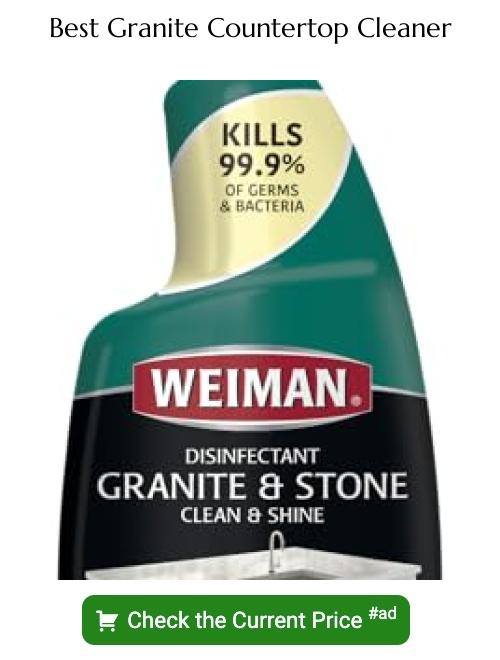Last updated on
Discover the essential factors to consider when selecting the perfect granite for your kitchen countertops, ensuring a beautiful and durable surface that enhances your space.
Granite countertops are a popular choice for kitchens due to their durability, beauty, and ability to increase the value of a home. However, with so many options available, choosing the right granite for your kitchen can be overwhelming.
From color to pattern to finish, there are numerous factors to consider before making a decision. In this article, we’ll guide you through the process of selecting the perfect granite for your kitchen countertops.
So let’s dive in and discover how you can make an informed decision that will enhance both the functionality and aesthetics of your kitchen space!
What's Inside
Importance of Granite Countertops
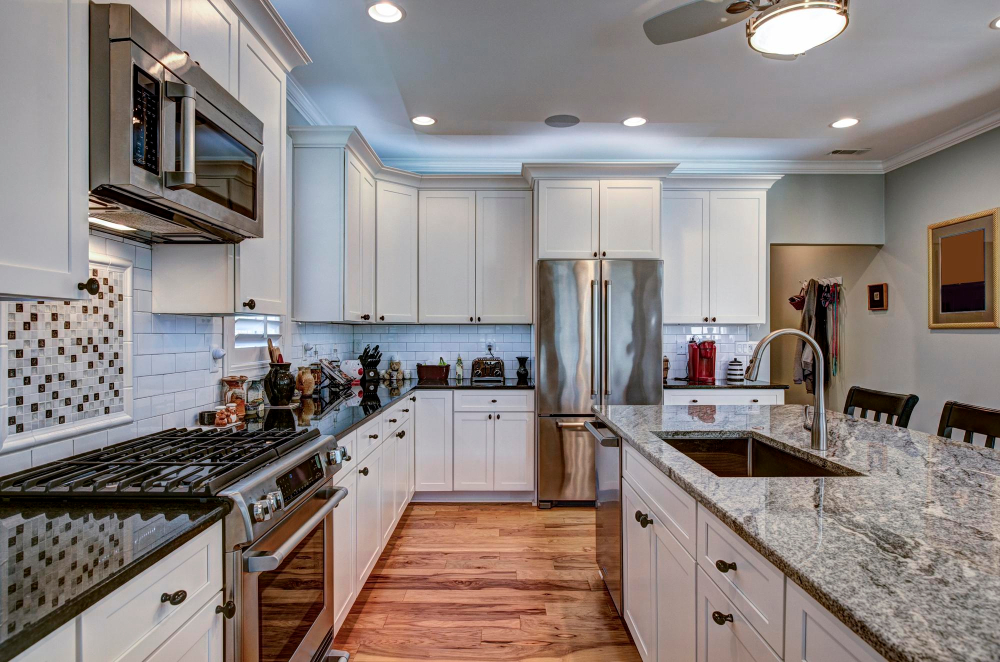
Granite countertops are a popular choice for homeowners due to their durability, beauty, and ability to increase the value of a home. Granite is an igneous rock that forms from the slow crystallization of magma beneath the earth’s surface.
It is one of the hardest natural stones available and can withstand high temperatures without damage or scratching. This makes it ideal for use in kitchens where hot pots and pans are frequently placed on surfaces.
In addition to its durability, granite also offers unique patterns and colors that add character to any kitchen space. Each slab has its own distinct pattern created by variations in mineral content during formation which means no two slabs will ever be exactly alike.
Furthermore, granite countertops require minimal maintenance compared with other materials such as wood or laminate which need regular sealing or refinishing over time. With proper care such as wiping up spills promptly with mild soap and water followed by drying with a soft cloth, your granite countertop will last for decades while maintaining its original luster.
Types of Granite
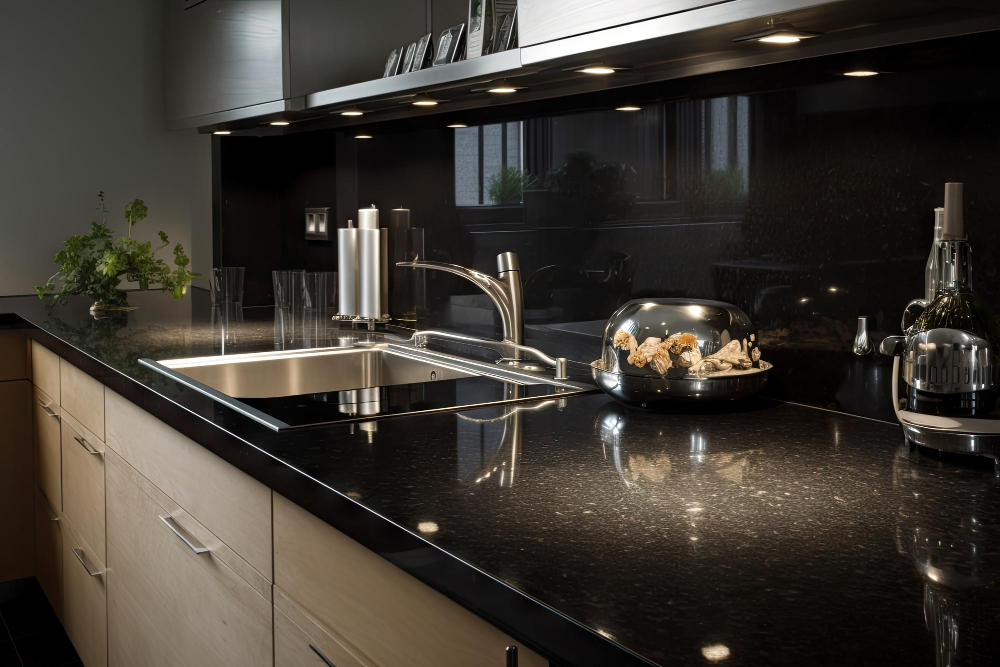
The most common types of granite used for kitchen countertops include Ubatuba, Black Galaxy, Absolute Black, and Santa Cecilia. Ubatuba is a dark green granite with flecks of gold and white that can add depth to your kitchen space.
Black Galaxy has black background color with small golden speckles throughout the surface giving it an elegant look.
Absolute black granite has no visible pattern or veining on its surface making it perfect for modern kitchens while Santa Cecilia features warm beige tones mixed with brown and gray hues creating a cozy ambiance in any kitchen.
When selecting the type of granite for your countertop project consider factors such as durability, maintenance requirements as well as how well they will complement other elements within your home’s decor scheme.
Granite Color Selection
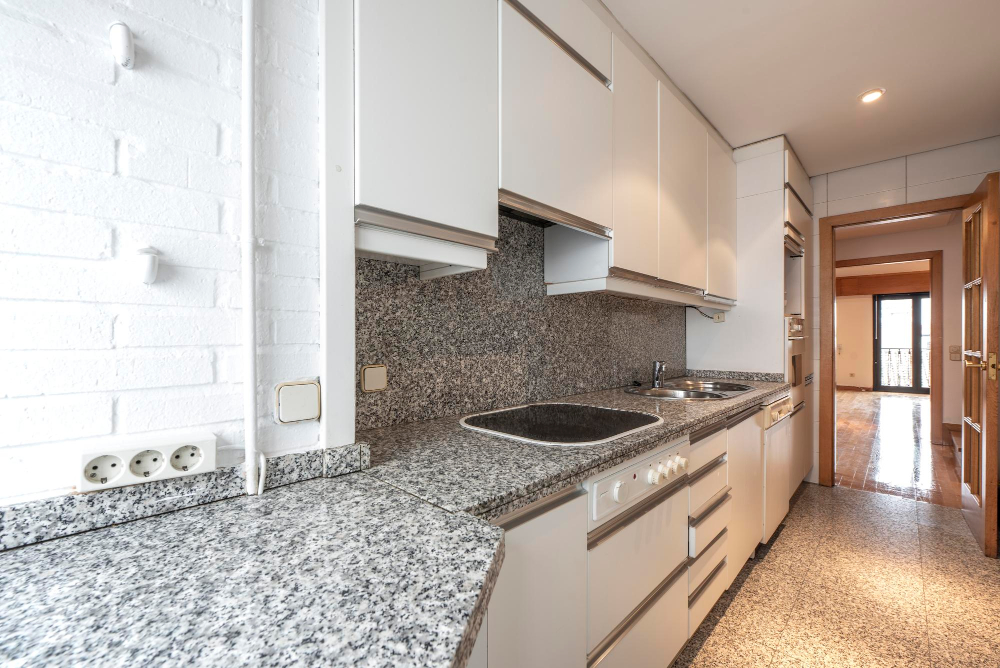
When selecting the color for your kitchen countertops, it’s essential to consider the overall design scheme of your space. If you have neutral cabinetry or walls, you may want to opt for a granite with more movement or veining that adds visual interest without overwhelming the space.
On the other hand, if you have colorful cabinets or backsplash tiles already installed in your kitchen, choosing a simpler granite color can help balance out the look.
It’s also important to keep in mind that different lighting conditions can affect how granite appears in your home. Natural light will bring out different tones than artificial light sources such as overhead fixtures and under-cabinet lights.
Granite Pattern Varieties
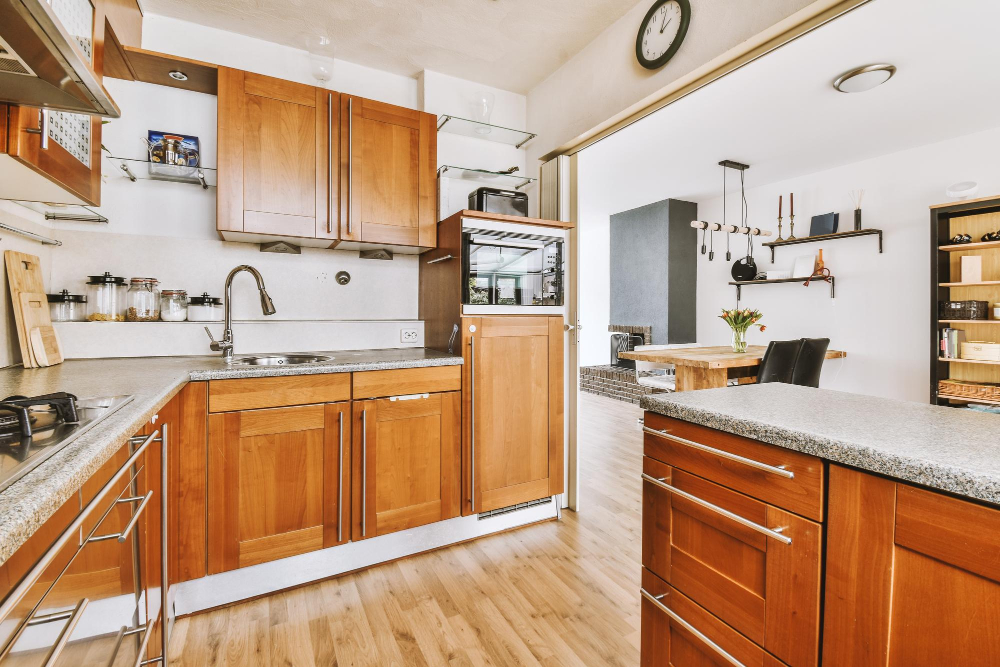
The pattern is determined by the minerals present in the stone and how they are arranged during formation. Some granite patterns have large veins or swirls, while others have small speckles or flecks that create a more uniform appearance.
When choosing a granite pattern for your kitchen countertops, consider the overall style of your space and what will complement it best. For example, if you have modern cabinetry with clean lines and minimalistic design elements, you may want to opt for a granite pattern with smaller speckles or subtle veining.
On the other hand, if you prefer traditional-style kitchens with ornate details and warm colors on cabinets and walls; then go for bold-patterned granites such as Azul Aran which has blue-grey hues mixed together creating an eye-catching look.
Granite Thickness
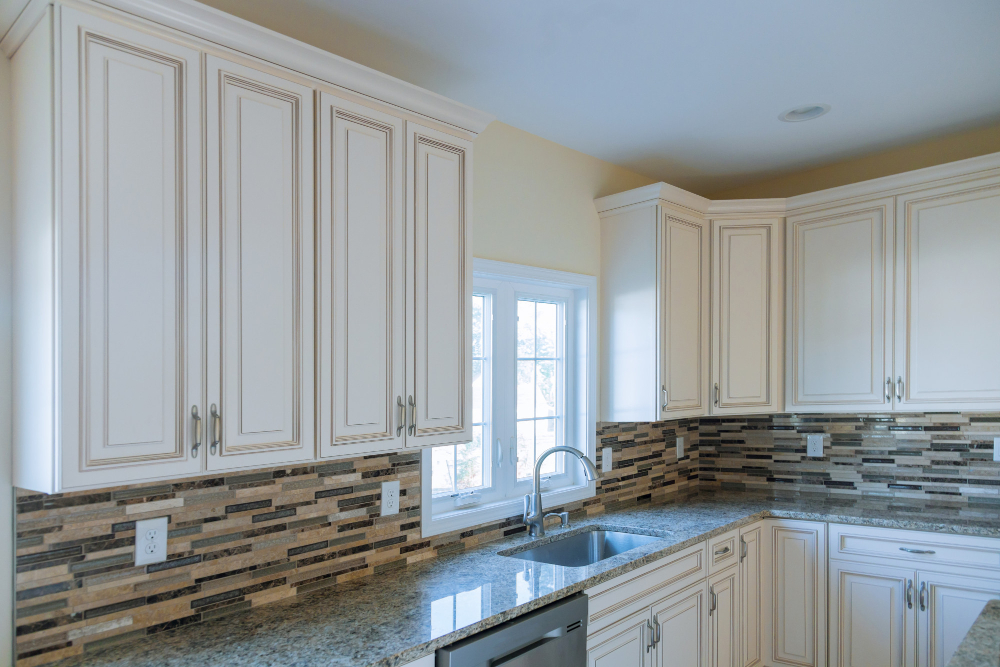
The standard thickness for granite countertops is 1-¼ inches, but you can also find them in other sizes ranging from ¾ inch to 3 inches. Thicker slabs are more durable and less likely to crack or chip over time, making them a popular choice among homeowners.
However, thicker slabs come with a higher price tag due to their weight and difficulty in handling during installation. They may require additional support structures underneath the cabinets.
On the other hand, thinner slabs are lighter and easier to handle during installation but may not be as durable as thicker ones. They also tend to have limited edge options compared with thicker ones.
When choosing the right thickness for your granite countertop, consider factors such as budget constraints and personal preferences while keeping durability in mind.
Granite Edge Styles
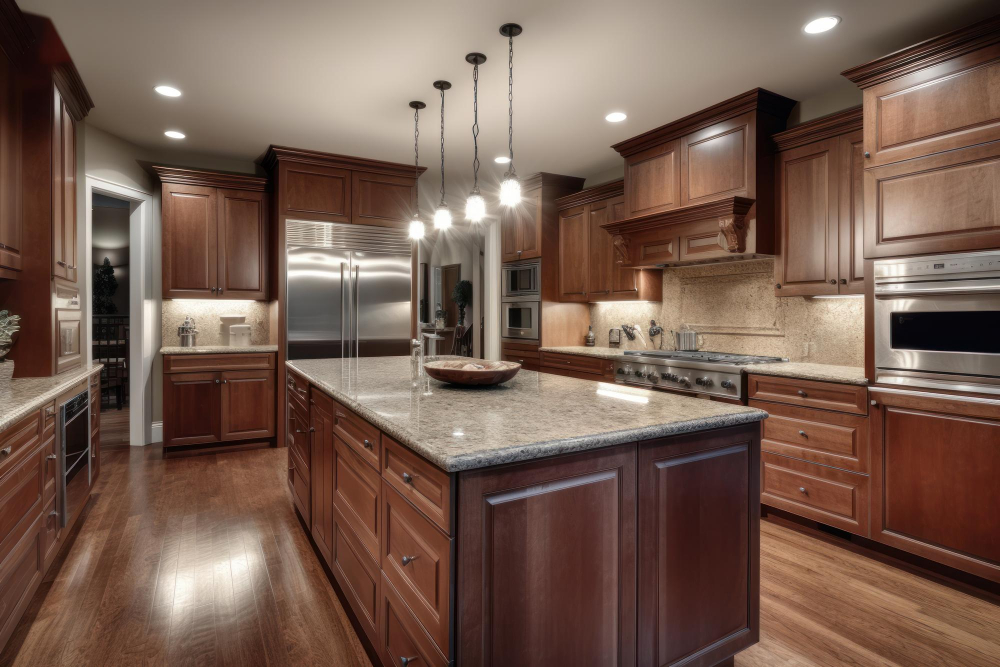
There are several options to choose from, each with its own unique characteristics. The most popular styles include bullnose, beveled, eased or pencil edge, ogee and waterfall.
Bullnose edges are rounded at the top and bottom for a smooth finish that is easy to clean. Beveled edges feature an angled cut along the top corner for added dimensionality while still maintaining a classic look.
Eased or pencil edges offer a simple straight-line design that complements modern kitchens well. Ogee edges provide an elegant touch with their S-shaped curve while waterfall edging creates an eye-catching cascading effect down one side of the countertop.
Choosing the Right Finish
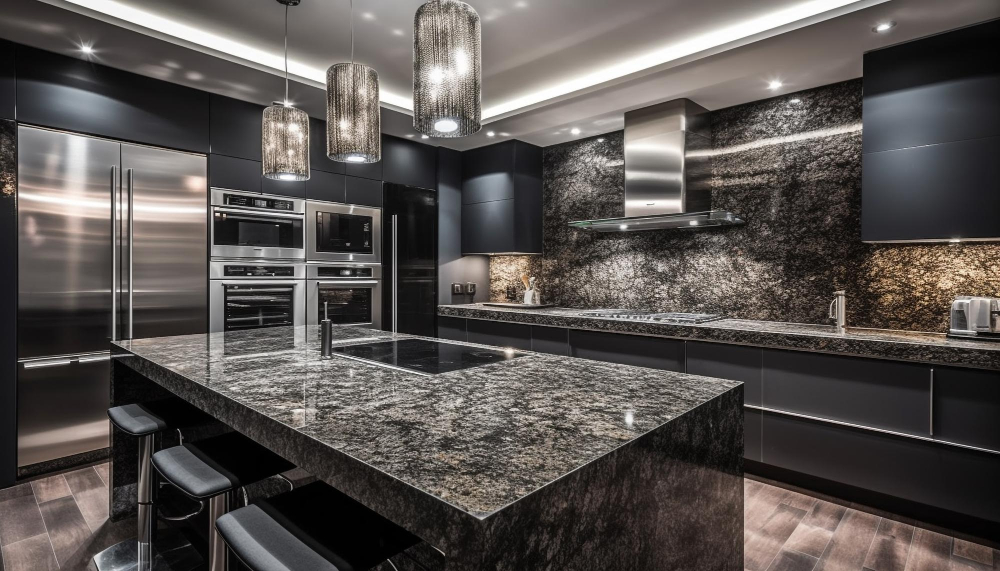
There are several finishes to choose from, including polished, honed, leathered, and brushed. A polished finish is the most popular choice for granite countertops as it provides a glossy surface that reflects light beautifully.
However, this type of finish can also show scratches more easily than other options.
A honed finish offers a matte look that is less reflective but still smooth to the touch. This option may be better suited for homeowners who prefer an understated look or want to minimize visible scratches.
Leathered and brushed finishes offer unique textures that add depth and character to your kitchen space while also hiding fingerprints and water spots well.
When choosing the right finish for your granite countertops consider factors such as maintenance requirements (some finishes require more upkeep than others), aesthetic preferences (what style do you want?), functionality needs (how will you use them?), budget constraints (some finishes cost more than others), among other things.
Comparing Granite Grades
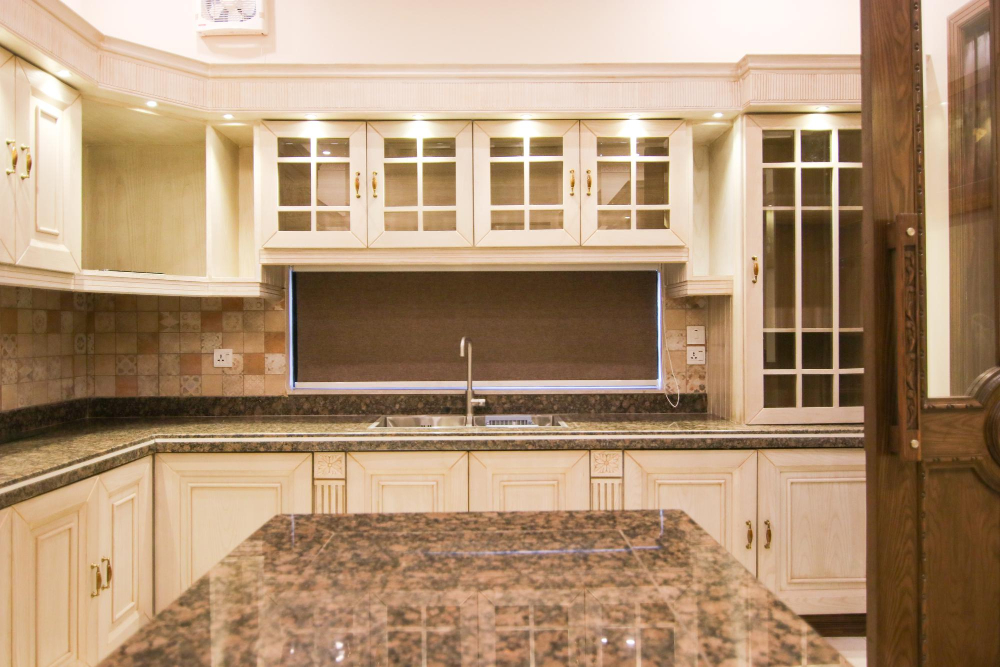
These grades are based on the quality and characteristics of the stone. Understanding these differences can help you make an informed decision about which grade is best suited for your needs.
The most common grading system used in the industry includes three levels: low-grade, mid-grade, and high-grade. Low-grade granite typically has more soft minerals mixed in with its natural strong minerals than higher rated stones do; this makes it less durable but also less expensive.
Mid-Grade Granite is a bit stronger than low grade because it has fewer soft minerals mixed in with its natural strong ones; however, it’s still not as durable as high-end options.
High-Grade Granite offers superior durability due to having very few or no weak spots within its structure making them ideal for heavy use areas like kitchen countertops that will see daily wear and tear over time.
Pricing Considerations

It’s important to set a budget before beginning your search for granite countertops and stick to it. Keep in mind that while lower-priced options may seem appealing, they may not be as durable or long-lasting as higher-end options.
Consider any additional costs such as installation fees and transportation costs if purchasing from a supplier outside of your local area. Some suppliers also offer discounts for larger orders or remnants from previous projects.
It’s essential to do your research when comparing prices between different suppliers and types of granite. Don’t hesitate to ask questions about pricing breakdowns or negotiate with suppliers if possible.
Eco-friendly Granite Options

Opting for locally sourced granite reduces transportation emissions and supports local businesses. Some quarries use sustainable practices to minimize their environmental impact.
Another eco-conscious choice is recycled or reclaimed granite. This type of stone is made from leftover pieces of other projects or salvaged from demolished buildings and repurposed into new countertops.
When selecting your countertop material, be sure to ask about the quarry’s sustainability practices and look for certifications such as LEED (Leadership in Energy and Environmental Design) certification which ensures a product meets strict environmental standards.
Inspecting Granite Slabs
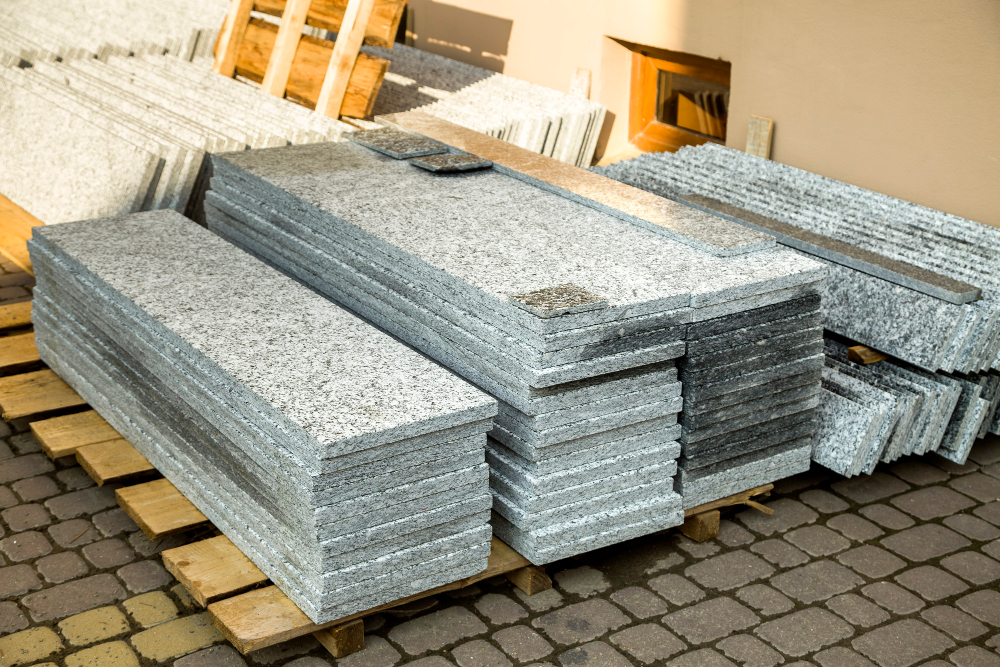
Inspecting the slab allows you to ensure that it meets your expectations in terms of color, pattern, and quality. It also helps you avoid any surprises during installation.
During inspection, check for cracks or chips on the surface of the slab as well as its edges. These imperfections can affect both appearance and durability over time.
Also look out for veins or discolorations that may not be visible from a distance but could become more apparent once installed.
Another important factor to consider is thickness consistency across all slabs if using multiple pieces in one area such as an island countertop or backsplash.
Maintenance and Durability
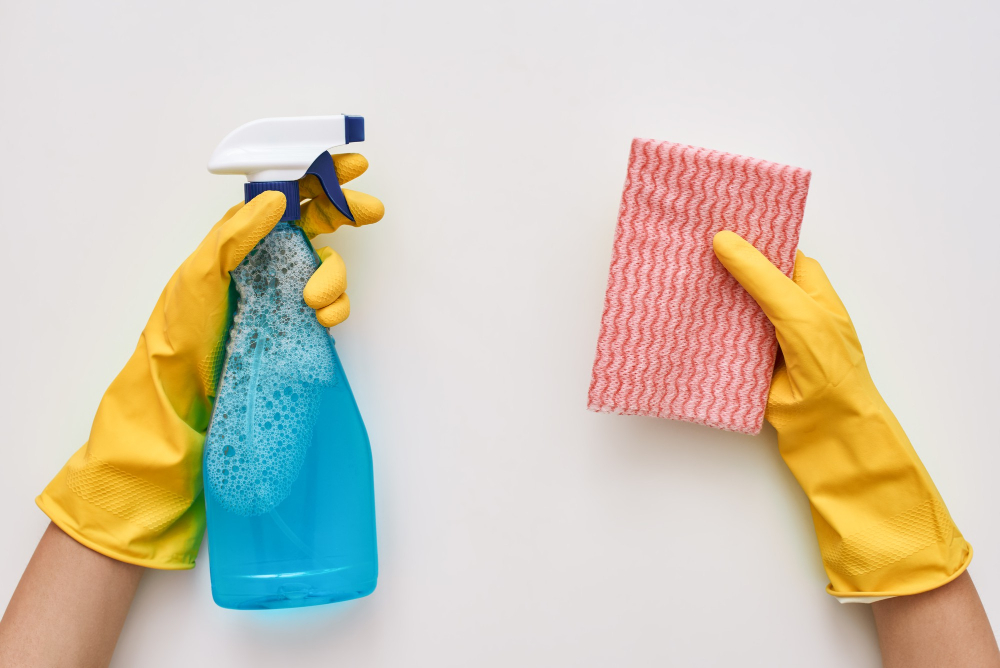
Granite is a porous material that can absorb liquids and stains if not sealed properly. It’s recommended to seal your granite countertops every year or two, depending on usage.
To clean your granite countertop, use warm water and mild soap with a soft cloth or sponge. Avoid using abrasive cleaners or scrubbers as they can scratch the surface of the stone.
While granite is heat-resistant, it’s still important to use trivets or hot pads when placing hot pots and pans on the surface. This will prevent any potential damage from thermal shock.
In terms of durability, granite ranks high among other countertop materials such as laminate and quartz due to its resistance against scratches, chips, cracks,and general wear-and-tear over time.
Coordinate With Cabinetry
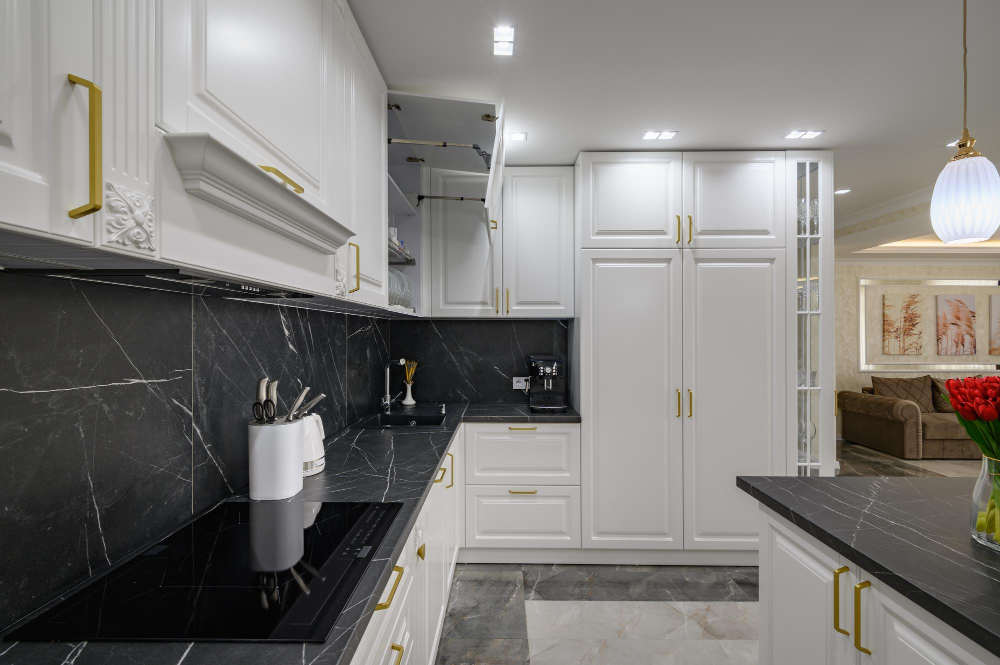
The color and style of the cabinets can significantly impact the overall look of your kitchen space. If you have dark wood cabinets, lighter colored granite countertops can provide a beautiful contrast that enhances the richness of the wood grain.
On the other hand, if you have light-colored or white cabinetry, darker shades of granite can add depth and dimension to space while providing an elegant touch.
It’s also important to consider any patterns or veining in both your cabinet doors and chosen slab as they should complement each other without competing for attention. For example, if you have intricate detailing on your cabinet doors such as raised panels or beading lines then choosing a simple patterned countertop would work best.
Kitchen Size Considerations
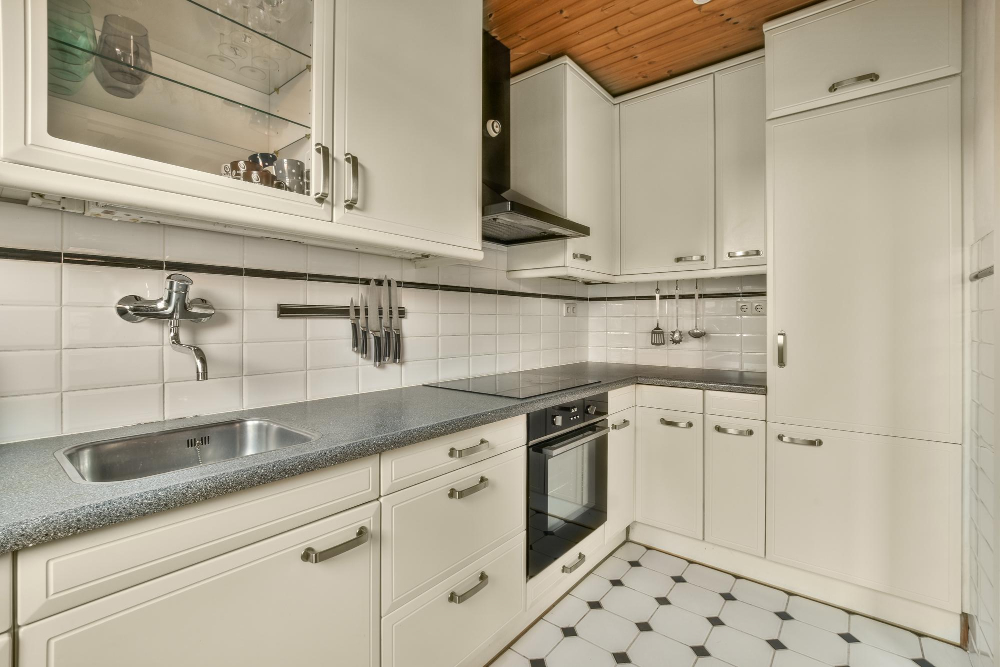
The amount of countertop space you have will determine how much granite you need and what type of pattern or color would work best. For smaller kitchens, lighter colors and simpler patterns can make the space feel more open and less cluttered.
On the other hand, larger kitchens can handle bolder colors and more intricate patterns without feeling overwhelming.
Another factor to consider is whether or not you want an island in your kitchen. Islands require additional countertop material which means a higher cost for installation.
However, they also provide extra workspace that can be invaluable when cooking large meals or entertaining guests.
Ultimately, choosing the right granite for your kitchen countertops comes down to personal preference as well as practical considerations such as size constraints.
Popular Pairings
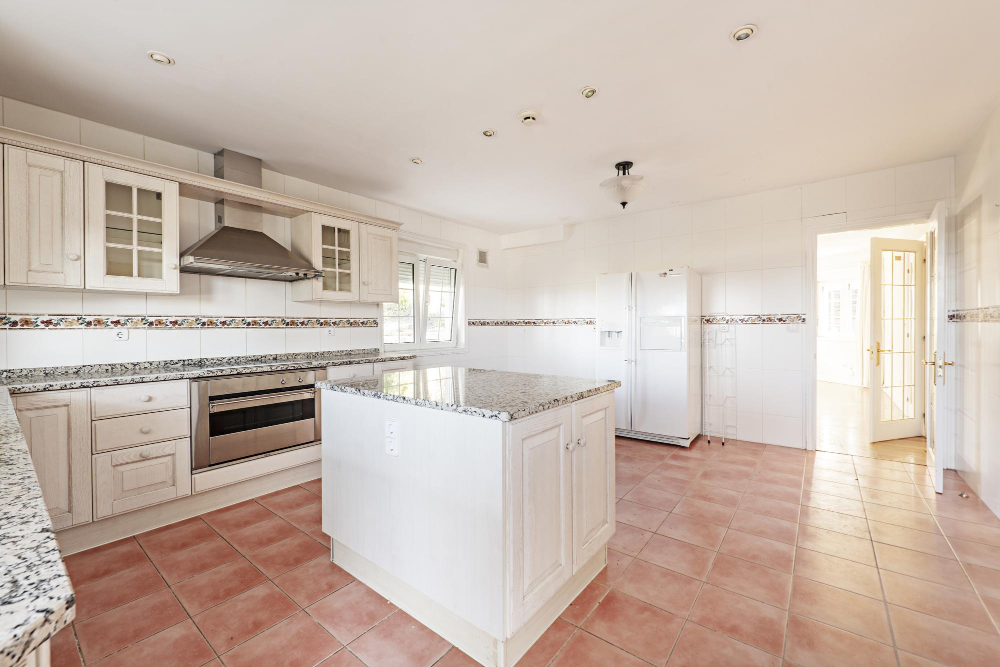
Some popular pairings include pairing black or dark gray granite with white cabinetry for a classic look, while lighter shades of granite can be paired with darker cabinets to create contrast. If you have a colorful backsplash or flooring in your kitchen, choosing neutral-toned granite can help balance out the space.
Another trend is mixing and matching different types of stone materials in one space. For example, combining marble countertops on an island with complementary colored quartzite on perimeter counters creates visual interest while still maintaining cohesiveness.
Determine Your Taste

Granite comes in a wide range of colors and patterns, so it’s essential to choose one that complements your personal style and existing decor. Consider the overall aesthetic you want to achieve in your kitchen space – do you prefer a classic look or something more modern? Are you drawn towards bold colors or subtle hues? Do you want a patterned surface or something more uniform?
Take inspiration from magazines, online resources, and even friends’ kitchens for ideas on what styles appeal most to you. It’s also helpful to visit showrooms where granite slabs are displayed so that you can see them up close and get an idea of how they might look in your own home.
Ultimately, choosing the right granite for your kitchen countertops is about finding a balance between functionality and aesthetics while staying true to what appeals most personally.
Installation Process
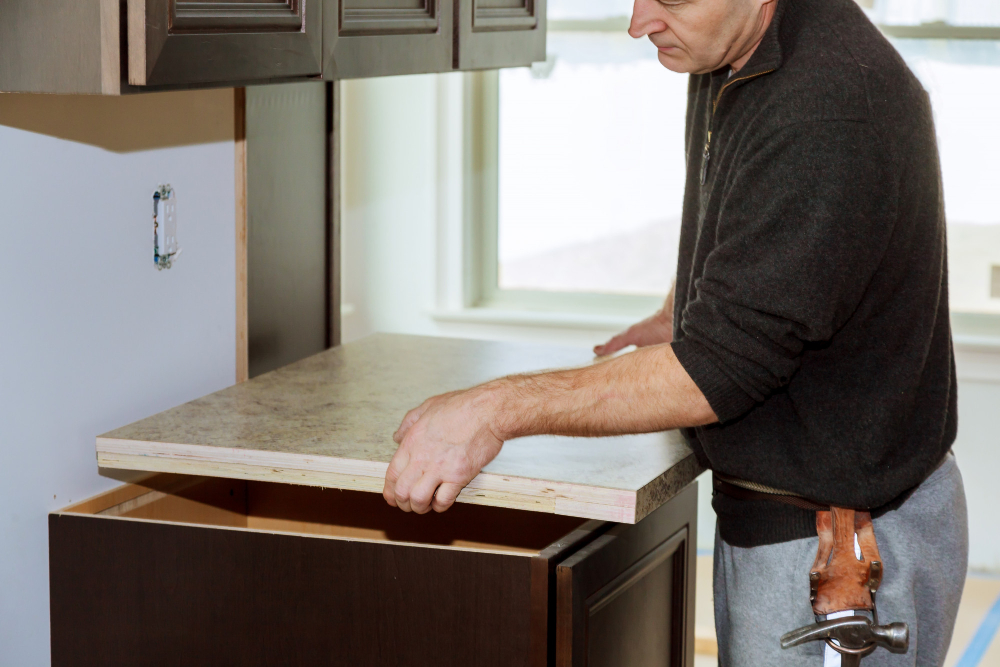
Installing granite countertops is a complex task that requires precision and expertise. It involves measuring, cutting, polishing and sealing of the stone slabs before they can be installed in your kitchen.
The first step in installing granite countertops is taking accurate measurements of your countertop space. This ensures that the slab fits perfectly into place without any gaps or unevenness.
Next comes cutting and shaping of the slab according to measurements taken earlier using specialized tools such as diamond saws or water jets. The edges are then polished smooth for a finished look.
After this stage, sealant is applied onto both sides of each piece before being placed on top of cabinets with adhesive material like silicone caulk which helps hold them securely in place while also preventing moisture from seeping through cracks between pieces over time causing damage underneath them due exposure from liquids spilled during cooking activities etcetera.
DIY Vs Professional Installation

While some homeowners may be tempted to tackle this project themselves, it’s important to weigh the pros and cons of DIY versus professional installation.
If you have experience with home improvement projects and access to specialized tools, a DIY approach could save you money on labor costs. However, keep in mind that installing granite countertops requires precision cutting and leveling skills that can take years of practice to master.
On the other hand, hiring a professional installer ensures that your new countertops are installed correctly without any costly mistakes or damage. Professionals have access to high-quality materials and equipment needed for proper installation.
Ultimately, whether you choose DIY or professional installation depends on your skill level and budget.
Common Mistakes to Avoid

One of the most significant errors is not inspecting the slab before purchasing it. It’s essential to examine the granite slab carefully and ensure that it doesn’t have any cracks or blemishes.
Another mistake is choosing a color or pattern based on current trends rather than personal preference. Trends come and go, but your countertop will be with you for years to come, so make sure you choose something that reflects your style and personality.
Many people overlook their cabinetry when selecting a granite countertop color. Your cabinets’ colors can significantly impact how well certain shades of granite complement them; therefore, it’s crucial to consider both elements together.
Lastly, don’t forget about maintenance requirements when making your selection. Some types of granites require more upkeep than others; if you’re not willing or able to commit time and effort into maintaining them properly over time – then they may not be suitable options for you in terms of practicality.
Wrapping It Up

Remember to take into account not only color and pattern but also thickness, edge style, finish type as well as maintenance requirements when making your selection.
It’s important to note that while granite is a durable material that adds value to any home; it does require proper care and maintenance. Be sure to follow manufacturer guidelines for cleaning and sealing regularly so that it remains in top condition.
Selecting the right granite countertop involves more than just choosing something aesthetically pleasing. By taking into account all aspects such as durability needs or eco-friendliness options available on today’s market – you’ll end up with a beautiful surface which will last years without losing its shine!
FAQ
How do I choose a granite top for my kitchen?
To choose a granite top for your kitchen, select the primary color in the granite that complements the dominant color in your kitchen, often the cabinets, or opt for matching veins or streaks for a subtler approach.
Which granite color is best for kitchen?
In a traditional kitchen setting, white granite is the top choice for its pure and classic appearance.
What is the ideal granite thickness for kitchen?
The ideal granite thickness for a kitchen is between 1 inch and 1.25 inches.
What factors should be considered while selecting a granite countertop material?
Factors to consider while selecting a granite countertop material include color, patterns, thickness, durability, resistance to stains, and cost.
How do different finishes of granite countertops affect the overall kitchen design?
Different finishes of granite countertops, such as polished, honed, and leathered, impact the overall kitchen design by creating distinct visual and tactile experiences.
Are there any effective methods to test the quality and durability of granite countertops before purchasing?
One effective method to test the quality and durability of granite countertops before purchasing is by examining their absorbency, scratch resistance, and performing the lemon juice test.
